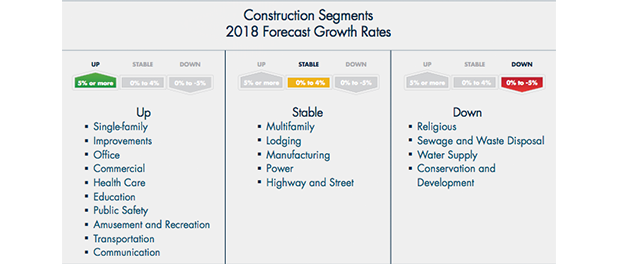By Roland Murphy for Arizona Builder’s Exchange
Management consulting and investment banking term FMI, which is, “dedicated exclusively to engineering and construction, infrastructure and the built environment,” has released its, “Construction Outlook First Quarter Report,” and is forecasting a 7 percent increase in total construction and engineering spending across the U.S. in 2018.
For comparison, 2017 ended the year with a 4 percent increase.
The three major sectors leading the growth trend will be residential improvements at 12 percent, office at 9 percent and single-family residential at 7 percent. Commercial, Healthcare, Education, Public Safety, Amusement/Recreation, Transportation, and Communication are also all expected to show gains of at least 5 percent over the year.
Projected to be in the 0-5 percent growth range, and suggesting either stabilizing after prior “hot” years or general levelling out are Multifamily, Lodging, Manufacturing, Power, and Highway and Street.
Five of the sectors FMI tracks are headed for a decrease, according to the report. These are Religious, Sewage/Waste Disposal, Water Supply, and Conservation/Development.
While AZBEX doesn’t track SFR or the home improvement sector, the major growth in these areas suggest at least one potential impact for the commercial projects in that the labor shortage isn’t going away any time soon. These jobs pay relatively well, and job completions and turnover are generally quicker. Given the reports of residential contractors in some areas going to job sites and hiring crews away on the spot to come work their projects, among other less anecdotal trends, 2018 will almost certainly see skilled labor shortages at least as bad, and possibly worse, than 2016 and 2017.
By Sector
FMI gives a snapshot view of each market. We’ll summarize them for you here with the sector, its percent change and an insight or two from the report.
The Gainers:
Improvements (+12): The tightening inventory in the SFR market is leading people to stay in their homes longer and invest in more wide-ranging improvements to enhance value when they do sell and move.
Office (+9): With the improvement in corporate tax rates due to 2017 legislation, companies are investing in workers and their workspaces, but a lack in high-tech office space could pose difficulties.
Commercial (+7): The ongoing rise of ecommerce-targeted warehousing and distribution continue to drive investment in new space, as do increased corporate profits from tax reform.
SFR (+7): Low unemployment, tight inventory and the risk of rising interest rates are pushing builders to create units as fast as they can.
Transportation (+7): Major airport expansion projects and repairs to storm-damaged ports will continue to boost this sector over the year.
Healthcare (+6): The shift away from large footprint hospitals to more focused-care outlets continues, permitting more projects and faster turnarounds.
Public Safety (+6): High growth areas need to invest in new public safety facilities. Also, correctional facility overcrowding is an ongoing problem.
Educational (+5): Half of the states are seeing increases in K-12 enrollment, and there is an increase toward building flexible spaces to handle year-round classes.
Amusement/Recreation (+5): Sports stadium and casino projects around the country have fueled a major uptick.
Communication (+5): Constant connectivity demands in corporate/distribution environments, as well as among workers in general, is generating investment.
Lodging (+4): Investment will continue to slow down as supply begins to exceed demand over this year and next.
Manufacturing (+4) Capacity utilization has been low, but improvements in tax structure and potential tariff changes are expected to require growth.
Multifamily (+4): Even with the high output nationally in recent years, vacancy remains low, and people who can’t find an acceptable single-family option are moving into multi- at high rates. The lower degree of growth for 2018 indicates, however, supply may be catching up.
Power (+3): While solar could be harmed by trade restrictions, gas-fired power plants are doing well, as are electric and gas transmission projects.
Highway/Street (+3): Risks for growth are the possibility of public-private partnerships not taking root and the ongoing lack of other federal project funding. However, many states are taking the reins themselves and implementing high taxes/user fees to fund projects.
The Losers
Religious (-4): New tax deduction rules are expected to decrease donations, and more denominations are occupying non-dedicated spaces.
Water Supply (-3): Funding is limited and technology improvements have reduced the level of immediate need in recent years.
Sewage & Waste Disposal (-1): As with Water Supply, funding is limited, but the growth in residential will continue to increase need and demand.
Conservation/Development (-1): Investment will increase through 2019 due to ongoing hurricane cleanup in Texas and Florida.

